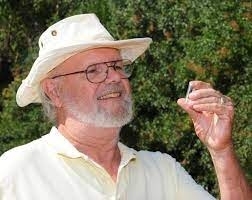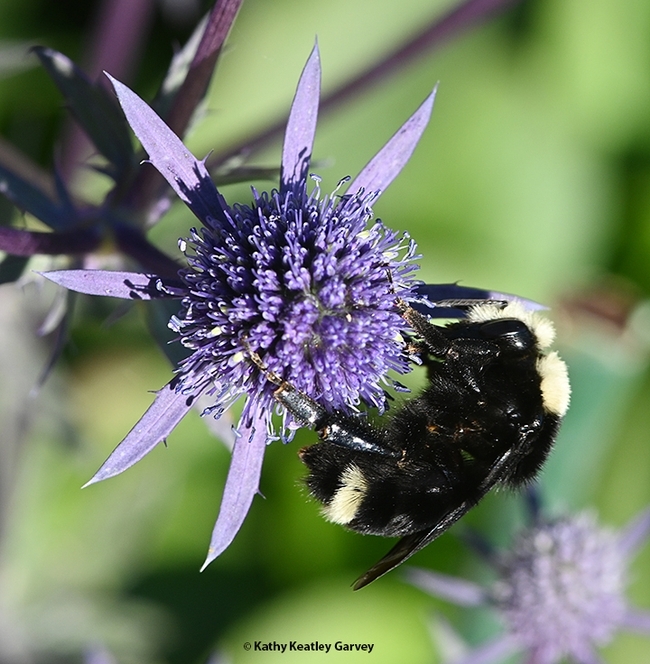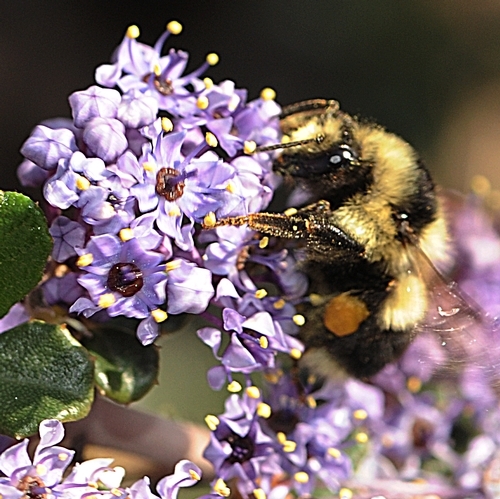
And the plant may be a manzanita or ceonothus.
The Bohart Museum of Entomology is sponsoring its fourth annual Robbin Thorp Memorial First-Bumble Bee-of-the-Year Contest, which begins at 12:01, Jan. 1, 2024. The first person to photograph a bumble bee in either Yolo or Solano and email it to the sponsor, the Bohart Museum, will receive a coffee cup designed with the endangered Franklin's bumble bee, the bee that Thorp monitored along the California-Oregon border for decades.
Contest coordinator Lynn Kimsey, director of the Bohart Museum, said the image must be taken in the wild and emailed to bmuseum@ucdavis.edu, with the time, date and place.
The contest memorializes Professor Thorp (1933-2019), a global authority on bees and a UC Davis distinguished emeritus professor of entomology, who died June 7, 2019 at age 85. A 30-year member of the UC Davis faculty, he retired in 1994 but continued working until several weeks before his death. Every year he looked forward to seeing the first bumble bee in the area.
The previous winners:
2023: Ria deGrassi of Davis took a video of a Bombus melanopygus foraging on a Ceanothus in her backyard on Jan. 8 She had purchased the plant from the Arboretum plant sales.
2022: Maureen Page, then a doctoral candidate in the lab of pollination ecologist and professor Neal Williams, UC Davis Department of Entomology and Nematology, and horticulturist Ellen Zagory, retired director of public horticulture for the Arboretum, tied for first by each photographing a bumble bee foraging on manzanita (Arctostaphylos) in the Arboretum. The time: 2:30 p.m., Saturday, Jan. 1. Page, who now holds a doctorate in entomology, photographed a Bombus melanopygus, while Zagory captured an image of the yellow-faced bumble bee, Bombus vosnesenskii.
2021: Postdoctoral researcher Charlie Casey Nicholson of the Neal Williams lab and the Elina Lastro Niño lab, UC Davis Department of Entomology and Nematology, won the 2021 contest by photographing a B. melanopygus at 3:10 p.m., Jan. 14 in a manzanita patch in the Arboretum.
Thorp, a tireless advocate of pollinator species protection and conservation, co-authored two books in 2014, during his retirement: Bumble Bees of North America: An Identification Guide (Princeton University,) and California Bees and Blooms: A Guide for Gardeners and Naturalists (Heyday). Every year he looked forward to finding or seeing the first bumble bee in the area. He co-taught The Bee Course from 2002 to 2019. An intensive nine-day workshop affiliated with the American Museum of Natural History and held annually at the Southwestern Research Station, Portal, Ariz., it draws participants from around the world, includkng conservation biologists, pollination ecologists, and other biologists who want to gain greater knowledge of the systematics and biology of bees.
For years, Thorp monitored Franklin's bumble bee, found only in a small range in Southern Oregon and Northern California, and now feared extinct. He last spotted it in 2006.
The bumble bee contest originated in 2012 with the "Bombus posse" of Thorp, Allan Jones, Gary Zamzow, Kim Chacon and Kathy Keatley Garvey, who engaged in a friendly contest to see who could find the first bumble bee of the year in the two-county area. The first bumble bee to emerge in the area is usually the black-tailed bumble bee. B. melanopygus, Thorp used to say. Another early bumble bee is the yellow-faced bumble bee, B. vosnesenskii.
The Bohart Museum, located in Room 1124 of the Academic Surge Building, 455 Crocker Lane, UC Davis campus, houses a global collection of eight million insect specimens. It also houses a live petting zoo and an insect-themed gift shop. It is open to the public from 8 a.m. to noon, and from 1 to 5 p.m., Monday through Thursday, excluding university holidays.
Attached Images:

